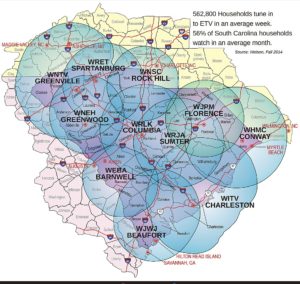
By Lindsay Street, Statehouse correspondent | South Carolina has long invested in infrastructure that is becoming pivotal for public school students learning at home in the pandemic: television.
South Carolina Educational Television (SCETV)’s public broadcasting is known for helping young children learn from “Sesame Street” and “Super Why,” but its role shifted to aiding teachers with remote-learning in the early days of the coronavirus in the state.
Now as the new school year approaches, the broadcast network will expand K-12 programming while piloting an initiative that allows teachers to use its existing infrastructure to beam content into a student’s device, such as a tablet issued through a school, without the need for an internet connection.

“I’m not saying it’s a replacement for broadband. I still want to keep that focus. It needs to happen, but I do think this is a great supplement to that,” Fort Mill Republican Rep. Raye Felder said. “It’s a perfect opportunity to continue educating outside of classrooms.”
Since 1957, SCETV has grown to cover nearly every household in the state with a network of 11 television stations and eight radio stations. Each can be picked up using an antenna and a TV.
“We can capitalize on what they’ve already done,” Great Falls Democratic Sen. Mike Fanning said.
From March 25 until June 5, the stations aired 259 hours of curriculum-based programming on its regular channels and shared the program schedule with school districts around the state for teachers to include in their instruction. This will be expanded in the fall, according to SCETV.
Didn’t know about it? An SCETV survey of mostly teachers found that about 37 percent used the At-Home resources as part of their teaching curriculum. And while SCETV presented its work at the House Education and Public Works Committee meeting Aug. 4, not all lawmakers and staffers got the memo.

Fanning — an educator — said he was unaware of how SCETV is adapting content in the pandemic. He even asked school officials at eight districts about it and heard crickets, he said.
Felder said she’s aware of the disconnect.
“I don’t think the public is aware of how much SCETV stepped in early on when we closed down the schools. ETV immediately altered its programming to give students an opportunity to at least watch lessons,” she said. “As the new school year starts, more and more districts will try to come up with innovative and creative ways to notify parents of all the options that are available and I’m hoping ETV will be one of those … Every household may not have a computer, more households have television.”
SCETV Vice President of Education Stephanie Frazier said the agency has worked over the summer to spread awareness, mostly through schools and teachers.
“The effort has been there but we are in the middle of a pandemic,” she said, adding that there has been some marketing on radio, TV ads and more for the general public.
‘Rooted in education services’
In the 1970s, SCETV expanded its reach into nearly every home in the state and began offering closed circuit programs inside schools, higher education and other state agency training. In 1998, it launched an initiative to prepare children for the first grade. In 2004, it launched StreamlineSC, a resource offering more than 10,000 educational videos, corresponding lesson plans and quizzes for every public and private school in the state.
In short, the educational content was mostly already there. So the initial pivot on programming to help supplement teacher lessons took only days to implement.

“Our mission is rooted in education services,” Frazier said.
She said morning content on the television channels focused on younger children, and content from 1 p.m. to 4 p.m. focused on middle school- and high school-content on a variety of subjects. Schools were sent schedules so teachers could notify students of content, she said. The educational program schedule was also published online at SCETV.org so guardians and parents can also help students tune in.
“We had the ability to make some modifications and we have a robust inventory of educational resources,” Frazier said.
While the broadcasted lessons relied mostly on the agency’s existing inventory of educational programming, the agency is working to record some teacher-led lessons for the fall, Frazier said.

The content is supposed to supplement virtual teaching or packets that were sent home. Frazier said the agency offers reflection worksheets for students.
SCETV also debuted this summer a series on YouTube with “Storytime” to combat a student slide in summer reading, and has worked to instruct 5,000 teachers on using SCETV resources and teaching virtually since March, according to Frazier.
Old infrastructure, new technology
The agency is also looking at using its old infrastructure in new ways.
Public agencies have used technology for public safety and public emergencies for years — think of emergency threat texts sent directly to a smartphone. So what if school lessons could be delivered that same way?
That’s the idea behind SCETV’s latest pilot program called datacasting (data plus broadcasting). The technology reportedly converts a portion of the existing SCETV broadcasting infrastructure for one-way transmission of data.
The pilot program began in April and includes school districts in York, Laurens, Fairfield and Jasper counties, according to Frazier.
The data does not go into television sets (although it could eventually, Frazier said) but is sent directly into a device, which could be a parent’s smartphone or a tablet offered through the school district, according to Frazier.
“We are able to use our existing infrastructure so we can at least get started,” she said.

SCETV Commissioner Ray Sharpe, who works with cable companies, said the technology will be “quite helpful” for remote learning.
“Some of these areas are so remote that some providers are saying it could be five to 10 years before they have broadband services — that is a perfect example of how datacasting could help citizens of South Carolina,” he said.
Felder said the content can be “very individualized” from teacher to teacher, and down to just a handful of students.
“They can do this throughout the state with the towers already there and it does not require internet. The disadvantage is that it’s one-way information,” she said.
The state of South Carolina has received $15 million in additional CARES Act funds to enhance remote learning for students that live in rural areas, according to SCETV Director of Communications Jeremy Cauthen. Some of that money — though the exact amount is not known yet — will go toward expanding the datacasting initiative, Cauthen said. It will depend on the number of school districts and students participating in the initial datacasting pilot programs.
- Have a comment? Send to: feedback@statehousereport.com
















 We Can Do Better, South Carolina!
We Can Do Better, South Carolina!